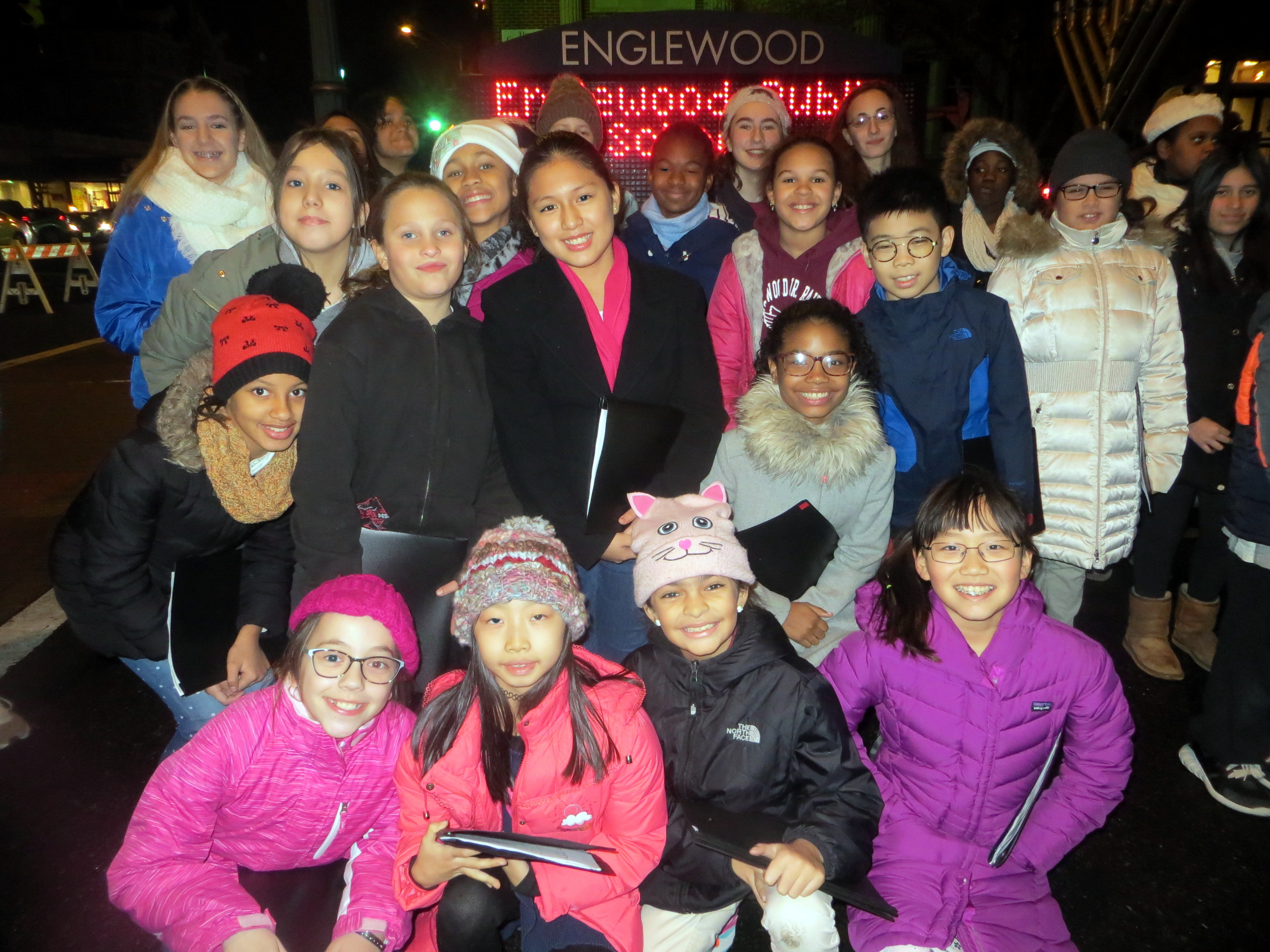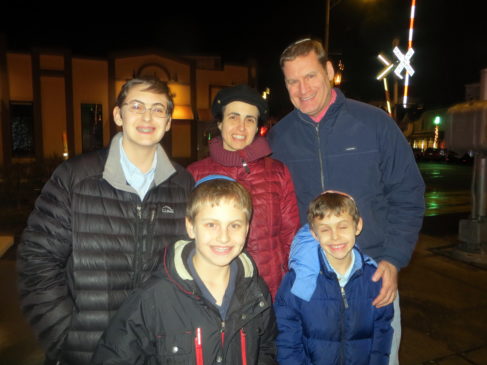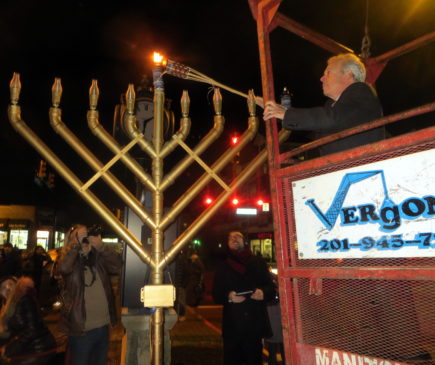
BY HILLARY VIDERS
SPECIAL TO NORTHERN VALLEY PRESS
ENGLEWOOD, N.J. —— On Tuesday evening, Dec. 12, an exuberant crowd of over 200 people gathered in front of city hall in Englewood to watch the lighting of the menorah, heralding the beginning of Hanukkah.
[slideshow_deploy id=’899′]
Hanukkah (or Chanukah, from the Hebrew word meaning “dedication”) is the eight-day Jewish holiday known as the Festival of Lights. It commemorates the victory in the 2nd century B.C. of a small group of Jewish people, the Maccabees, who, against impossible odds, drove out a barbaric enemy from their homeland in Jerusalem.
Rabbi Simon from Friends of Lubavitch of Bergen County hosted this 13th Menorah Lighting, an annual citywide event organized by the Englewood Chamber of Commerce. He was joined by several other rabbis, including Rabbi Poupko from Congregation Ahavath Torah and Rabbi Michoel Goldin.
Simon and Poupko both spoke eloquently about the significance of the holiday.
Simon remarked that “the menorah and the story of Hanukkah represent the victory of light over darkness, of good over evil and that goodness and kindness is more powerful than the forces of negativity. In times such as these, where we need more light and more goodness in the world, I am so grateful to the city of Englewood who helps us coordinate this lighting so that together we can bring the message of lights of the menorah to the world.”
There were several city officials at the menorah lighting, including Mayor Frank Huttle III who gave a short speech welcoming everyone and thanking Rabbi Simon. Also present, were Councilwomen-elect Cheryl Rosenberg and Katharine Glynn, and Councilmen Eugene Skurnick and Michael Cohen.
The ceremony began with Mayor Huttle lighting the Shamash, the light in the middle of the menorah which is used to illuminate the candles each night of Hanukkah.
Rosenberg and her four children then lit the first night’s Hanukkah candle (every year, a different family is selected for the honor). They were hoisted up in a large crane provided by Vergona. When the crane reached the proper height, Rosenberg reached out with a large Tiki torch to light the candle.
[slideshow_deploy id=’899′]
Besides the candle lighting ceremony, there were delicious treats for all — latkes (fried potato pancakes) provided by Hummus Elite and a variety of donuts. There were also bags filled with chocolate coins (Hanukkah “gelt”), and dreidels for the children.
Entertainment was provided by the Junior Chorus of the Thurnauer School of Music at the JCC on Palisades. The choir of 54 children was directed by Renata Kapilevich and conducted by Emma Brondolo. They performed a dozen classic Hanukkah songs such as, “My Dreidel,” “Hanukkah O Hanukkah,” and “Mazel Tov.”
Flanked by dozens of delighted families and choir members, Chamber President Carol Rauscher was impressed at how popular the city’s menorah lighting ceremony has become.
“This is by far the largest turnout that we’ve ever had for this event. The chamber is pleased to share this great tradition with residents and the general public.”
The story of Hanukkah
Hanukkah recalls the time of ancient history in 168 B.C. when the Jewish Temple in Jerusalem was seized by Syrian-Greek soldiers and dedicated to the worship of the god Zeus. The Jewish people were distraught, but many were afraid to fight back against these well-armed invaders for fear of reprisals.
The Syrian-Greek emperor Antiochus made the observance of Jewish rituals an offense punishable by death and ordered all Jews to worship Greek gods. Greek soldiers forcibly gathered the Jewish villagers and told them to bow down to an idol, then eat the flesh of a pig—both practices that are forbidden to Jews.
STORY CONTINUES BELOW



Villagers that refused were slaughtered. A few courageous Jews took to the hills of Judea in open revolt. Led by Mattathias, and later his son Judah the Maccabee, a small band of pious Jews engaged in guerrilla warfare against the Syrian-Greek army. These rebels became known as the Maccabees. After three years, the Maccabees beat incredible odds and miraculously succeeded in driving the enemy from their land. Once the Maccabees had regained control, they returned to the Temple in Jerusalem. By this time it had been spiritually defiled by being used for the worship of foreign gods and also by practices such as sacrificing swine.
Jewish troops were determined to purify the Temple by burning ritual oil in the Temple menorah for eight days. But to their dismay, they discovered that there was only one day worth of oil left in the Temple. They lit the menorah anyway and to their surprise, the small amount of oil lasted the full eight days.
This is the miracle of the Hanukkah oil that is celebrated every year when Jews light a special menorah, known as a “hanukkiyah,” for eight days. One candle is lit on the first night of Hanukkah, two on the second, and so on, until eight candles are lit.
Every community has its unique Hanukkah traditions, but there are some that are universally practiced: lighting the Menorah, spinning the dreidel, giving gifts and eating latkes (fried potato pancakes) and donuts.
Lighting the menorah: Every year it is customary to commemorate the miracle of the Hanukkah oil by lighting candles on a menorah. The menorah is lit with candles every night for eight nights.
Spinning the dreidel: A popular Hanukkah game is spinning the dreidel, which is a four-sided top with Hebrew letters written on each side. Gelt, which are chocolate coins covered with tin foil, are part of this game.
Eating fried foods: Because Hanukkah celebrates the miracle of oil, it is traditional to eat fried foods such as latkes, the pancakes made out of potatoes and onions, and donuts, because they are fried in oil.
Gift Giving: Many families celebrate Hanukkah by giving children a gift on each of the eight nights of Hanukkah.
[slideshow_deploy id=’899′]
The spiritual message of Hanukkah is universal. For centuries, the story of Hanukkah has been recounted around the world, not only in history books and folklore, but also in literature. Emma Lazarus, the 19th century poet whose famous words, “Give me your tired, your poor…” are inscribed on the pedestal of the Statue of Liberty, also wrote a moving poem about Hanukkah, that includes the verse: “Still ours the dance, the feast, the glorious Psalm, The mystic lights of emblem, and the Word.”
Photos by Hillary Viders
